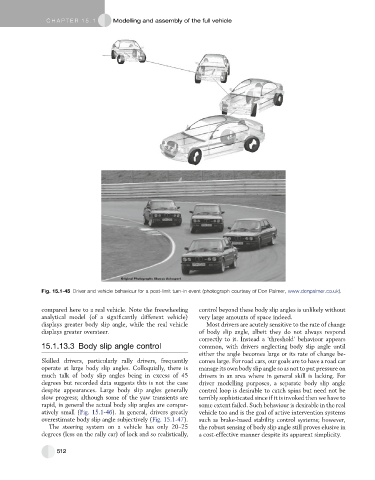Page 504 - Automotive Engineering Powertrain Chassis System and Vehicle Body
P. 504
CHAP TER 1 5. 1 Modelling and assembly of the full vehicle
Fig. 15.1-45 Driver and vehicle behaviour for a post-limit turn-in event (photograph courtesy of Don Palmer, www.donpalmer.co.uk).
compared here to a real vehicle. Note the freewheeling control beyond these body slip angles is unlikely without
analytical model (of a significantly different vehicle) very large amounts of space indeed.
displays greater body slip angle, while the real vehicle Most drivers are acutely sensitive to the rate of change
displays greater oversteer. of body slip angle, albeit they do not always respond
correctly to it. Instead a ‘threshold’ behaviour appears
15.1.13.3 Body slip angle control common, with drivers neglecting body slip angle until
either the angle becomes large or its rate of change be-
Skilled drivers, particularly rally drivers, frequently comes large. For road cars, our goals are to have a road car
operate at large body slip angles. Colloquially, there is manage its own body slip angle so as not to put pressure on
much talk of body slip angles being in excess of 45 drivers in an area where in general skill is lacking. For
degrees but recorded data suggests this is not the case driver modelling purposes, a separate body slip angle
despite appearances. Large body slip angles generally control loop is desirable to catch spins but need not be
slow progress; although some of the yaw transients are terribly sophisticated since if it is invoked then we have to
rapid, in general the actual body slip angles are compar- some extent failed. Such behaviour is desirable in the real
atively small (Fig. 15.1-46). In general, drivers greatly vehicle too and is the goal of active intervention systems
overestimate body slip angle subjectively (Fig. 15.1-47). such as brake-based stability control systems; however,
The steering system on a vehicle has only 20–25 the robust sensing of body slip angle still proves elusive in
degrees (less on the rally car) of lock and so realistically, a cost-effective manner despite its apparent simplicity.
512

